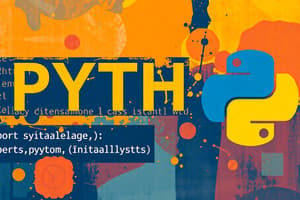Podcast
Questions and Answers
What is the definition of a module?
What is the definition of a module?
- An error handling feature
- A data structure
- A file containing Python definitions and statements (correct)
- A type of function in Python
Import lets you _______
Import lets you _______
import modules into a Python script
What is the simplest way to import a module?
What is the simplest way to import a module?
import math
How do you import multiple modules at once?
How do you import multiple modules at once?
How does a module work?
How does a module work?
How do you use something from a module?
How do you use something from a module?
Can an imported entity have the same name as something already in the file?
Can an imported entity have the same name as something already in the file?
How do you import specific things from a module?
How do you import specific things from a module?
How do you import all entities from a module?
How do you import all entities from a module?
What is it called to import a module as another name?
What is it called to import a module as another name?
When using 'from' to import, which is the best option?
When using 'from' to import, which is the best option?
Study Notes
Module Overview
- A module in Python is a file that contains definitions and statements, allowing for organized code management.
Importing Modules
- The
importstatement is used to bring modules into a Python script for reuse of code.
Basic Import Syntax
- The simplest method to import a module is by using
import module_name, for example,import math.
Importing Multiple Modules
- Multiple modules can be imported simultaneously using:
import module_1, module_2- Or separately defined:
import module_1import module_2
Module Functionality
- Python checks for the existence and accessibility of the specified module. If found, it imports all defined names, which remain separate from the current namespace.
Using Module Entities
- Access an entity from a module by using the syntax:
module_name.entity_name, e.g.,math.pi.
Name Conflicts
- It is possible for imported entities to share names with existing identifiers in the file. Example:
import mathdef pi(x): return x- Accessing
math.piresolves to the module'spi.
Importing Specific Entities
- Specific functions or variables can be imported using:
from module import entity_name, e.g.,from math import pi.- Multiple imports can be done as well:
from module import pi, sin.
Importing All Entities
- To import everything from a module, use:
from module import *.- This practice should be temporary due to potential name conflicts.
Aliasing Modules
- Modules can be imported under a different name, a process known as aliasing. Example:
import math as alias- Access using
alias.pi. - Functions can also be aliased:
from module import function_1 as fun.
Best Practices for Imports
- The recommended way to import and use functions is:
from module_1 import function- Followed by calling the function directly:
function().
Studying That Suits You
Use AI to generate personalized quizzes and flashcards to suit your learning preferences.
Description
Test your knowledge of Python modules with these flashcards from Edube Module 1. Each card provides definitions and examples related to importing and using modules in Python. Perfect for beginners looking to enhance their understanding of Python programming.




